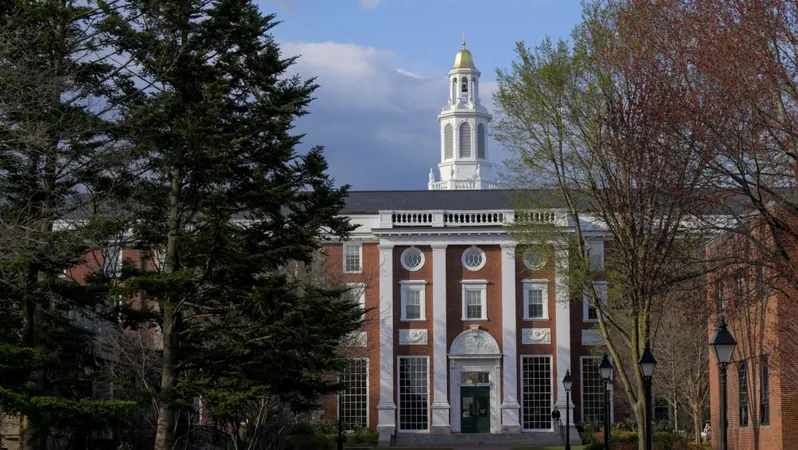
Unlocking the Mysteries of Neuroblastoma: New Insights from a Groundbreaking Cell Atlas
2025-04-14
Author: Nur
Revolutionary Research Sheds Light on Neuroblastoma
At the forefront of childhood cancer research, experts from the Children's Hospital of Philadelphia (CHOP) have unveiled a groundbreaking longitudinal atlas of neuroblastoma—one of the most dangerous cancers affecting kids. This innovative research aims to decode the complex molecular mechanisms that render many treatments ineffective over time.
In a significant publication in Nature Genetics, the researchers share crucial insights that could pave the way for personalized medicine in battling neuroblastoma, where the five-year survival rate for high-risk cases lingers below 50%.
The Challenge of Treatment Variability
Neuroblastoma cells can differ drastically even within the same tumor, complicating treatment outcomes significantly. Until now, there has been a considerable gap in understanding how the tumor microenvironment evolves during therapy.
Creating a Comprehensive Cell Atlas
The researchers crafted a detailed cell atlas, offering an unprecedented glimpse into the dynamic interactions between malignant cells and immune cells within the tumor's natural setting. "Our atlas lays the groundwork for new treatment developments by mapping the intricate relationships between cancerous cells and their supportive surroundings," explained Dr. Kai Tan, Ph.D., who leads CHOP's efforts in the National Cancer Institute's Human Tumor Atlas Network.
Dr. Tan expressed optimism about harnessing these insights to customize therapies targeting the distinct characteristics of individual tumors.
Groundbreaking Techniques Unravel Tumor Mysteries
Utilizing cutting-edge single-cell sequencing and spatial omics, the researchers analyzed tumor samples from 22 pediatric patients diagnosed with high-risk neuroblastoma before and after receiving induction chemotherapy. Their comprehensive dataset is now available on the HTAN data portal.
Crucial Findings Lead to New Treatment Avenues
The study revealed startling variations in both tumor and non-tumor cell features and highlighted significant transformations following chemotherapy. Alarmingly, patients with highly proliferative cancer cells experienced poorer outcomes, while those with tumors exhibiting mature, neuron-like characteristics fared better.
Moreover, an increase in mesenchymal-like tumor cells was linked to unfavorable chemotherapy responses, while certain immune cells, such as macrophages, were found to inadvertently fuel tumor growth by promoting blood vessel formation while dampening immune defenses.
A Potential New Target for Treatment
The research unveiled a specific communication pathway (HB-EGF/ERBB4) between macrophages and cancer cells that signals tumor growth. These discoveries underscore the need to identify new elements within the tumor microenvironment that affect how high-risk neuroblastoma responds to treatments. The researchers are actively investigating this pathway using preclinical models, with hopes of translating these findings into innovative therapeutic strategies.
Collaboration: The Key to Progress
Lead author Dr. Wenbao Yu emphasizes that such extensive studies are made possible through collaborative efforts. "With the integration of biologists, clinicians, and computational scientists, we have gained unprecedented insights into the complex ecosystem of neuroblastoma."




 Brasil (PT)
Brasil (PT)
 Canada (EN)
Canada (EN)
 Chile (ES)
Chile (ES)
 Česko (CS)
Česko (CS)
 대한민국 (KO)
대한민국 (KO)
 España (ES)
España (ES)
 France (FR)
France (FR)
 Hong Kong (EN)
Hong Kong (EN)
 Italia (IT)
Italia (IT)
 日本 (JA)
日本 (JA)
 Magyarország (HU)
Magyarország (HU)
 Norge (NO)
Norge (NO)
 Polska (PL)
Polska (PL)
 Schweiz (DE)
Schweiz (DE)
 Singapore (EN)
Singapore (EN)
 Sverige (SV)
Sverige (SV)
 Suomi (FI)
Suomi (FI)
 Türkiye (TR)
Türkiye (TR)
 الإمارات العربية المتحدة (AR)
الإمارات العربية المتحدة (AR)